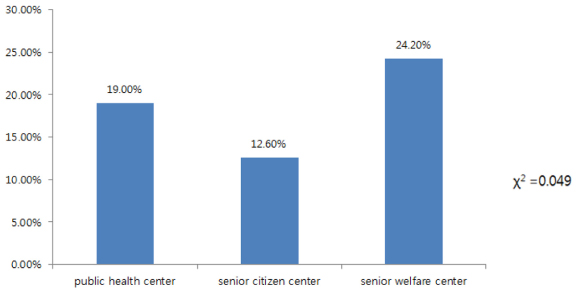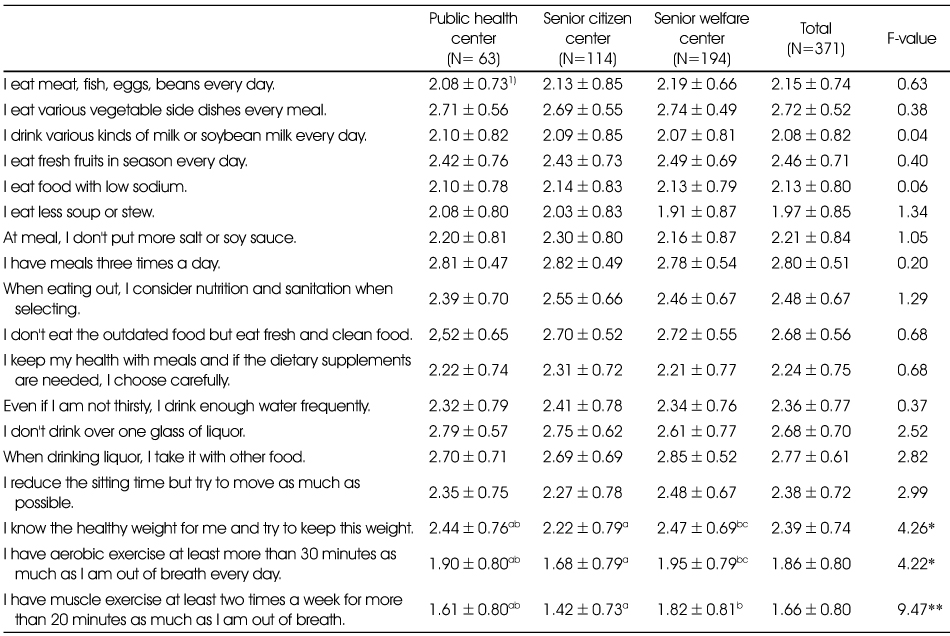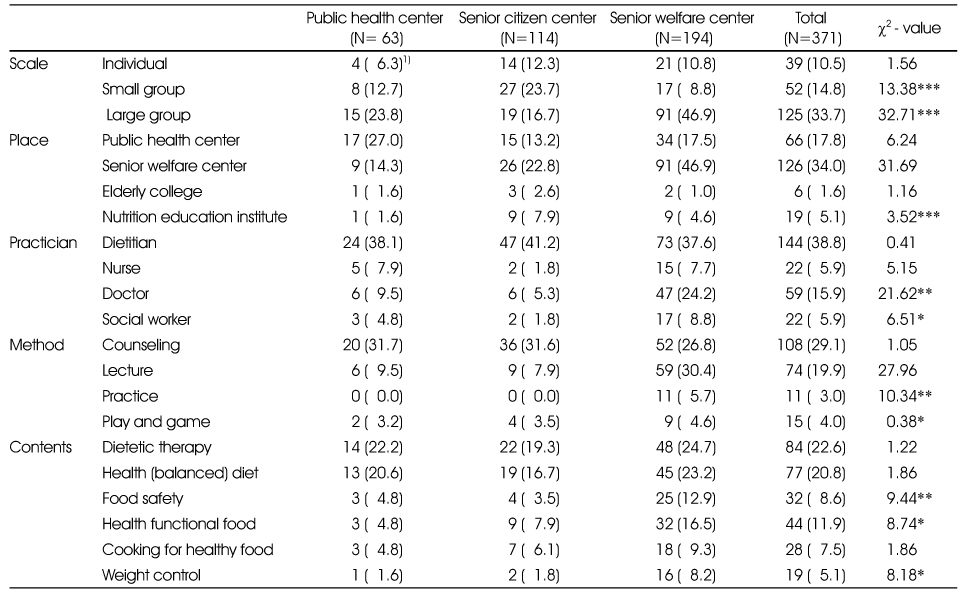Articles
- Page Path
- HOME > Korean J Community Nutr > Volume 21(1); 2016 > Article
-
Research Article
- A study on the Needs for Nutrition Management Program for Elderly Who use Welfare Facilities
-
Min-June Lee, Jung-Hyun Kim
 , Ok-Jin Park, Young-Mi Lee
, Ok-Jin Park, Young-Mi Lee -
Korean Journal of Community Nutrition 2016;21(1):65-74.
DOI: https://doi.org/10.5720/kjcn.2016.21.1.65
Published online: February 29, 2016
1)Graduate School of Education, Yonsei University, Seoul, Korea.
2)Department of Home Economics Education, PaiChai University, Daejeon, Korea.
3)Department of Tourism Management, Yeojoo University, Yeojoo, Korea.
4)Department of Food & Nutrition, Gachon Uiversity, Seongnam, Korea.
- Corresponding author: Jung-Hyun Kim. Department of Home Economics Education, PaiChai University, 155-40 Baejae-ro, Seo-gu, Daejeon, 35345, Korea. Tel: (042) 520-5424, Fax: 070-4362-6292, jhkim99@pcu.ac.kr
Copyright © 2016 The Korean Society of Community Nutrition
This is an Open-Access article distributed under the terms of the Creative Commons Attribution Non-Commercial License (http://creativecommons.org/licenses/by-nc/3.0/) which permits unrestricted non-commercial use, distribution, and reproduction in any medium, provided the original work is properly cited.
- 1,156 Views
- 5 Download
- 13 Crossref
Abstract
-
Objectives
- This study was performed to investigate the nutritional status, health conditions, eating habits and experience and demand for nutrition·dietary management of senior citizens. And these data are formed foundation of development of nutrition·dietary management education program and contents in welfare facilities for the aged.
-
Methods
- We visited 3 public health centers, 3 senior citizens centers, and 4 welfare centers in Seoul, Gyeonggi-do, Chungnam province, and Daejeon area and carried out interview by semi-structured questionnaire for senior citizens older than 65 years who use those facilities.
-
Results
- The study included 17%, 30.7% and 52.3% of senior citizens from public health centers, seniorcitizen centers and and welfare centers, respectively. The age range of 43.9% of the population was 65-74 years and and 56.1% were older than 75 years. We observed that 83.2% of subjects took some medicines due to diseases that they have and 58.0% took prescription medicines for hypertension. The thing that they considered the most when selecting food was 'the taste'(p<0.05). Regarding the level of practice to keep the dietary life, they answered more than 'average' for most of items but answered less than 'average' for lot of salt intake, drinking, exercise. For the experience of nutrition·dietary life education, only 19.8% answered 'Yes' and the service for nutrition·dietary life management showed the highest score in the demand for 'provide nutritious food'. For the size of consulting group for nutrition/dietary life education, the public health center and welfare center preferred a larger group size but the senior citizens center preferred a smaller group. With regard to who will carry out the consulting, the demand for dietitian was the highest and the operation type showed the high demand in the order of consulting, education. The contents that they want to have consultation in nutrition·dietary life education were diet therapy for diseases and the ordinary diet therapy for health.
-
Conclusions
- This study suggested the management of nutrition·dietry life necessitates qualitative measures according to the different types of welfare facilities. For these, it is in need of development of counseling and education program included therapy for disease. Above all, the policy to secure dietitian of welfare facilities for the aged to perform these should be achived.
- 1. Statistic Korea. Projected population and proportion [internet]. 2011; cited 2013 May 13]. Available from: http://kostat.go.kr.
- 2. Ministry of Health Welfare & Korea Centers for Disease Control and Prevention. Korea National Health and Nutrition Examination Survey [KNHANES V-1] [internet]. 2014; cited 2015 Dec 23]. Available from: https://knhanes.cdc.go.kr/knhanes/.
- 3. Lim YJ, Choi YS. Seasonal nutrient intakes of elderly women living alone as compared to those living family in the Gyeongbuk rural area. Korean J Community Nutr 2007; 12(1): 58-67.
- 4. Chang HJ. Strategies for the improvement of customer satisfaction on foodservice through identifying the foodservice quality factors in senior care facilities. Korean J Community Nutr 2008; 13(1): 69-79.
- 5. Choi JH, Lee ES, Lee YJ, Lee HS, Chang HJ, Lee KE, et al. Development of food safety and nutrition education contents for the elderly -by focus group interview and delphi technique-. Korean J Community Nutr 2012; 17(2): 167-181.Article
- 6. Lee MS. Health-related factors influencing the quality of life of rural elderly subjects -activities of daily living, cognitive functions, prevalence of chronic diseases and nutritional assessment. Korean J Community Nutr 2012; 17(6): 772-781.Article
- 7. Yim KS. The effects of a nutrition education program for hypertensive female elderly at the public health center. Korean J Community Nutr 2008; 13(5): 640-652.
- 8. Kwak CS, Cho JH, Yon MY, Park SC. Anthropometric index, dietary habits and nutrient intake of the oldest-old population aged 95 and over living in Seoul. Korean J Community Nutr 2012; 17(5): 603-622.Article
- 9. Bae JS, Kim MH, Kim SB. Effects of nutrition education and personalized lunch service program for elderly at senior welfare center in Jeonju. Korean J Community Nutr 2013; 18(1): 65-76.Article
- 10. Park JY, Kim JN, Hong WS, Shin WS. Survey on present use and future demand for the convenience food in the elderly group. Korean J Community Nutr 2012; 17(1): 81-90.Article
- 11. Kwak KS, Bae YJ, Kim MH. Nutritional status dietary quality in the low-income elderly residing at home or in health care facilities. J Korean Diet Assoc 2008; 14(4): 337-350.
- 12. Hong SY, Seo SH. Job performance frequency and the training needs of dieticians in elderly healthcare facilities. J Korean Diet Assoc 2010; 16(2): 160-177.
- 13. Cho EH, Chang HJ, Kwak TK. Analysis of the job activities and demand of dietitian in the elderly healthcare facilities. J Korean Diet Assoc 2006; 12(4): 313-328.
- 14. Choi BS, Kwon SY, Seo JY, Lee IS, Lee HJ. Comparison of nutrient intake and meal service satisfaction of elderly at the local community centers: Free and reduced meal service charge. Korean J Community Nutr 2005; 10(3): 303-310.
REFERENCES
Figure & Data
REFERENCES
Citations

- Spatial pattern and influencing factors of urban elderly meal assistance facilities: a case study from Beijing, China, based on multi-source data
Tuke Zheng, Xidong Ma, Xiaoqing Cheng
Journal of Asian Architecture and Building Engineering.2025; : 1. CrossRef - A study on the diet and nutrition management status and educational needs in elderly care facilities in Korea: focus group interviews with staff from children’s and social welfare meal management support centers and elderly care facilities
Seo Young Choi, Hyun joo Ryou, Jieun Oh
Korean Journal of Community Nutrition.2025; 30(4): 286. CrossRef - Snack Provision Practice in Long-Term Care Hospitals and Facilities in Korea
Dayeong Yeo, Hae Jin Kang, Hyejin Ahn, Yoo Kyoung Park
Clinical Nutrition Research.2024; 13(2): 108. CrossRef - Effectiveness of NQ-E index-based individual nutrition counseling for community-care elderly: an intervention study on improving nutritional status, complex chronic diseases, and quality of life
Yoonjeong Choi, Jihyun Lee, Heesook Lim, Yoo Kyoung Park
Korean Journal of Community Nutrition.2023; 28(6): 480. CrossRef - Evaluation on the Nutrition Quotient Scores of Elderly People Living Alone in Korea
Gyoungok Gang, Min Lee, Eun-hui Choi, Hye-Lim Lee, Hyun-Young Lee, Hye-Ja Chang, Jung-Hwa Choi, Na-Young Yi, Kyung-Eun Lee, Min-Jae Chung, Tong-Kyung Kwak
Nutrients.2023; 15(17): 3750. CrossRef - Effects of nutrition and hygiene education program on healthy eating habits and behavior of the elderly in Chungbuk
Je-ok Yeon, Byung-chun Song, Kyung-Jin Yeum, Myoung-sook Kim, Mi-young Lee
Journal of Nutrition and Health.2022; 55(3): 390. CrossRef - Dietary quality of lunches in senior leisure service facilities in South Korea: analysis of data from the 2013–2017 Korea National Health and Nutrition Examination Survey
Daeun Choi, Youngmi Lee, Haeryun Park, Kyunghee Song, Jinah Hwang
Nutrition Research and Practice.2021; 15(2): 266. CrossRef - Future Perspective of the Elderly Food in a Super-Aged Society
Weon-Sun Shin
Journal of the Korean Dysphagia Society.2021; 11(1): 1. CrossRef - Effects of a Person-Centered Nursing Intervention for Frailty among Prefrail Community-Dwelling Older Adults
Jiyeon Ha, Yeon-Hwan Park
International Journal of Environmental Research and Public Health.2020; 17(18): 6660. CrossRef - Socio-Economic Factors are Associated with Risk of Inadequate Protein Intake among Korean Elderly: Based on the Seventh Korean National Health and Nutrition Examination Survey (KNHANES Ⅶ), 2016-2018
Won Jang, Ho Kyung Ryu
The Korean Journal of Community Living Science.2020; 31(2): 215. CrossRef - Current Status of Sanitary and Nutritional Food Service in Elderly Day Care Center
Jeonghyeon Woo, Yoo Kyoung Park, Mi-Hyun Kim, Soo-Kyung Lee, Kyunghee Song, Hye-Kyeong Kim
Korean Journal of Community Nutrition.2020; 25(5): 374. CrossRef - Comparative analysis of dietary behavior and nutrient intake of elderly in urban and rural areas for development of “Village Lunch Table” program: Based on 2014 Korea National Health and Nutrition Examination Survey data
Youngmi Lee, Yourim Choi, Hae Ryun Park, Kyung Hee Song, Kyung Eun Lee, Chang Hee Yoo, Young Suk Lim
Journal of Nutrition and Health.2017; 50(2): 171. CrossRef - Food Safety and Nutrition Education Program for Elderly and Assessment of Program Effectiveness Based on Health Belief Model
Jung-Hwa Choi, Eun-Sil Lee, Yoon-Jin Lee, Hye-Sang Lee, Hye-Ja Chang, Kyung-Eun Lee, Na-Young Yi, Yoon Ahn, Tong-Kyung Kwak
Journal of the Korean Society of Food Science and Nutrition.2016; 45(9): 1366. CrossRef

Fig. 1
General characteristics of the subjects
1) N (%)
***: p < 0.001
Anthropometric measurements of the subjects
1) Mean±SD
**: p < 0.01
a,b: Different alphabets in same row are significantly different by Duncan's test.
Distribution of disease (by using drug)
1) N (%)
Frequency of meals and eating out
1) Mean±SD
*: p < 0.05
a,b: Different alphabets in same row are significantly different by Duncan's test.
Method of meal preparation
1) N (%)
*: p < 0.05, ***: p < 0.001
Considerations for food choice
1) N (%)
*: p < 0.05, **: p < 0.01, ***: p < 0.001
Practice of Dietary guidelines
1) 1=no / 2=average / 3=yes Mean±SD
*: p < 0.05, **: p < 0.01
a,b,c: Different alphabets in same row are significantly different by Duncan's test.
Needs for nutrition dietary habits management service
1) N (%)
*: p < 0.05
Needs for nutrition dietary habits education and counseling
1) The number (%) of cases who responded that nutrition·dietary habits education and counseling is needed
*: p < 0.05, **: p < 0.01, ***: p < 0.001
1) N (%) ***: p < 0.001
1) Mean±SD **: p < 0.01 a,b: Different alphabets in same row are significantly different by Duncan's test.
1) N (%)
1) Mean±SD *: p < 0.05 a,b: Different alphabets in same row are significantly different by Duncan's test.
1) N (%) *: p < 0.05, ***: p < 0.001
1) N (%) *: p < 0.05, **: p < 0.01, ***: p < 0.001
1) 1=no / 2=average / 3=yes Mean±SD *: p < 0.05, **: p < 0.01 a,b,c: Different alphabets in same row are significantly different by Duncan's test.
1) N (%) *: p < 0.05
1) The number (%) of cases who responded that nutrition·dietary habits education and counseling is needed *: p < 0.05, **: p < 0.01, ***: p < 0.001

 KSCN
KSCN










 Cite
Cite


